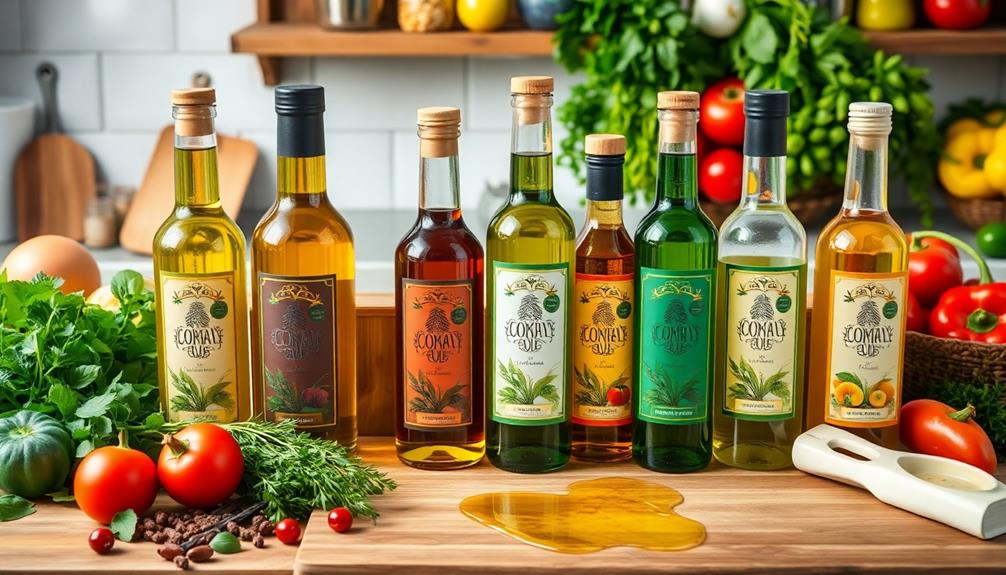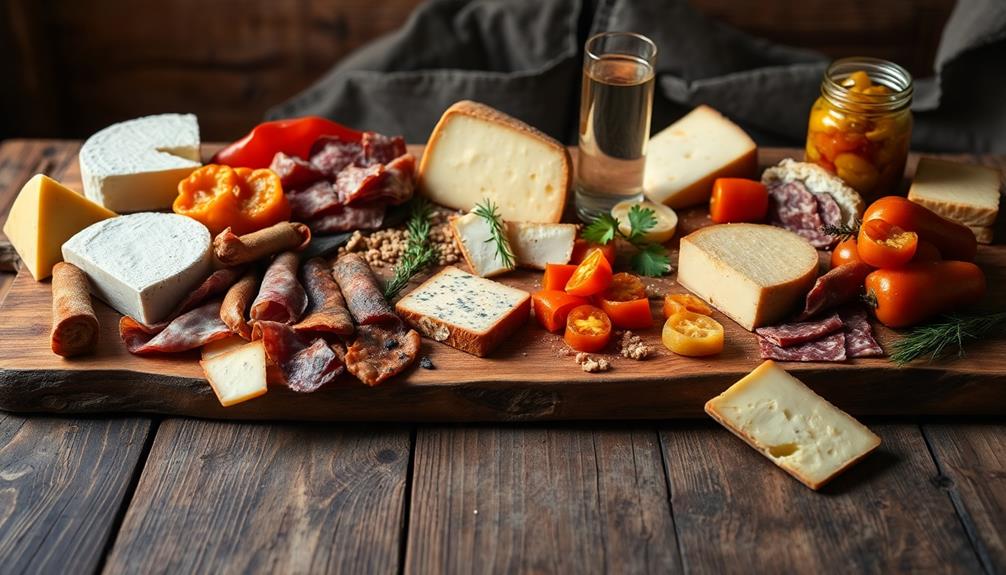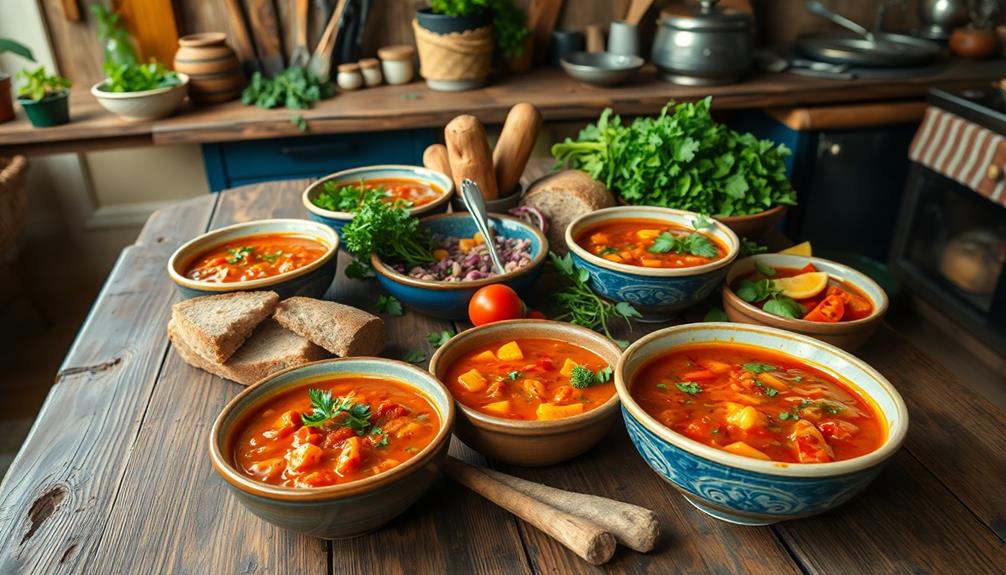During pregnancy, you're likely to crave certain foods due to hormonal shifts and changing nutritional needs. These cravings can be up to ten times stronger than your usual desires and often reflect your body's requirements, like calcium or vitamin C. You might find yourself longing for dairy or fruits as your body tries to meet these needs. Emotional and environmental factors also play a role, influencing what you crave. While it's normal to indulge, excessive cravings can lead to unhealthy weight gain. Discovering more about your cravings can help you manage them better and maintain a nutritious diet.
Key Takeaways
- Hormonal changes during pregnancy significantly heighten taste sensitivity, resulting in stronger cravings compared to pre-menstrual periods.
- Cravings can signal specific nutritional deficiencies, such as calcium or vitamin C, reflecting the fetus's needs.
- Emotional and psychological factors, including stress and cultural influences, can exacerbate cravings for comfort foods.
- Excessive cravings may lead to overindulgence in nutrient-poor foods, increasing risks for gestational diabetes and weight gain issues.
- Mindfulness and balanced meal planning are effective strategies for managing cravings while maintaining a healthy diet during pregnancy.
Overview of Pregnancy Cravings

Many women find themselves experiencing a range of food cravings during pregnancy, a phenomenon that's both common and captivating. You're not alone if you find yourself suddenly yearning for sweets, dairy, or starchy carbohydrates. In fact, studies show that around 50-90% of pregnant women report these cravings, often peaking in frequency and intensity during the second trimester.
Interestingly, some cravings can reflect cultural influences, as seen in traditional dishes like Muamba De Galinha, which features rich flavors and vital nutrients.
As your body undergoes significant changes, these cravings can signal nutritional needs. For instance, if you crave dairy, it might indicate your body's demand for calcium. Similarly, a strong desire for fruit could suggest you need more vitamin C.
It's worth noting that cravings can evolve throughout your pregnancy; savory foods often top the list in the first trimester, while sweet cravings may become more intense in the second.
While indulging in cravings can be tempting, it's essential to balance them with healthy food choices. By understanding your body's signals, you can navigate these cravings mindfully, ensuring you and your baby get the nutrients you both need.
Embrace this unique experience and listen to what your body is telling you!
Hormonal Influences on Cravings
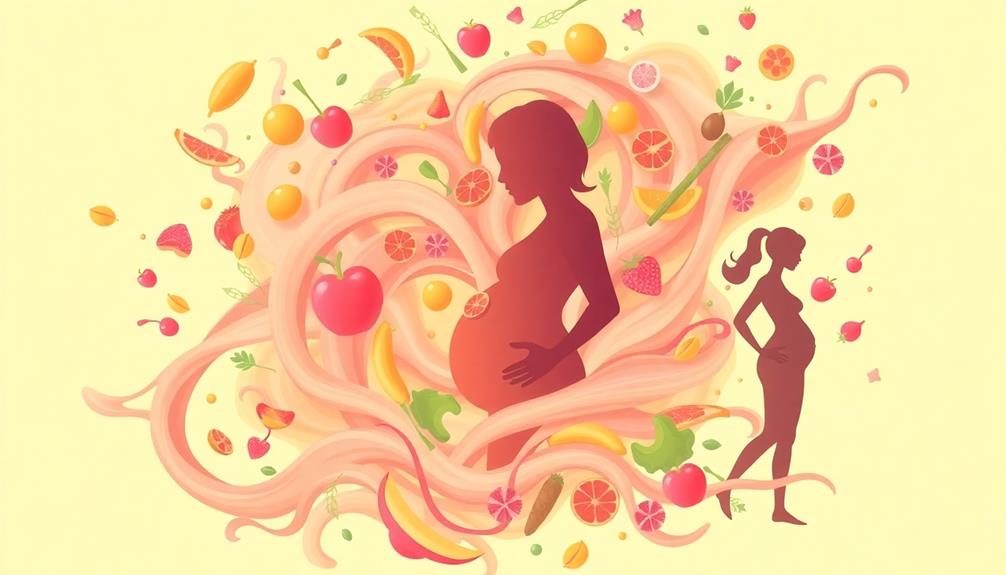
During pregnancy, hormonal changes play a crucial role in shaping your food cravings. Fluctuations in estrogen and progesterone heighten your taste sensitivity, making certain flavors and textures irresistible. This sensitivity can lead to a desire for rich and comforting foods, such as those found in culinary traditions from around the world.
Research shows that pregnancy cravings can be up to tenfold stronger than those you might experience during your pre-menstrual phase. This means you might suddenly find yourself longing for foods you never cared for before.
These hormonal shifts not only amplify cravings but can also turn you off foods you once loved, illustrating the complex interplay between hormones and your food preferences. While it's clear that hormonal changes greatly impact cravings, it's essential to acknowledge that there's no consistent evidence linking specific hormone levels to the intensity of these pregnancy cravings.
Understanding how hormones influence your cravings can empower you during this transformative time. By recognizing these effects, you can make healthier choices and manage your cravings more effectively.
If you have concerns about your cravings or dietary choices, consulting with health care professionals can provide guidance tailored to your needs, ensuring that both you and your baby stay healthy throughout your pregnancy journey.
Nutritional Deficiencies and Their Impact

During pregnancy, your cravings can be more than just random desires; they might signal specific nutritional deficiencies.
For instance, if you're craving dairy, it could mean your body needs more calcium, while a craving for fruit might indicate low vitamin C levels.
Additionally, cravings for certain foods may also reflect a desire for cultural flavors, such as traditional Brazilian sweets that provide essential nutrients.
Addressing these deficiencies is essential for both your health and your baby's development.
Common Nutrient Deficiencies
Pregnancy brings a host of changes to your body, and nutrient deficiencies can greatly impact both your health and your baby's development. Understanding common cravings during this time can help you identify potential nutrient deficiencies.
A craving for dairy products often signals a calcium deficiency, while a desire for fruits may suggest low vitamin C levels. If you find yourself reaching for high-calorie sweets, it could be due to increased caloric needs. Sour and salty cravings might reflect sodium loss, especially in early pregnancy. Unusual cravings for non-food items, known as pica, can indicate more serious deficiencies, such as iron-deficiency anemia.
To help you recognize these cravings and their meanings, here's a quick reference table:
| Craving Type | Possible Nutrient Deficiency |
|---|---|
| Dairy Products | Calcium Deficiency |
| Fruits | Vitamin C Deficiency |
| Non-food Items | Iron Deficiency (Pica) |
Regularly monitoring your nutrient intake and discussing your cravings with healthcare professionals is essential for maintaining a healthy diet during pregnancy and addressing any deficiencies.
Cravings as Nutritional Signals
Cravings can serve as your body's way of signaling nutritional needs, often pointing to deficiencies that require attention. For instance, if you find yourself longing for dairy products, it may indicate a calcium deficiency. Your body requires calcium for fetal bone development, making this craving a vital nutritional signal.
Additionally, cravings for rich, flavorful dishes like Mushroom Masala may suggest a desire for more complex carbohydrates and nutrients during this time.
Similarly, cravings for fruits might reflect low vitamin C levels, essential for both your immune function and your baby's health. You may also experience high-calorie sweet cravings, which could be linked to your increased caloric needs during pregnancy. Typically, you'll need an extra 200-300 calories in your second and third trimesters.
Early in pregnancy, if you're drawn to sour foods or salty snacks, this might suggest sodium loss, often caused by morning sickness.
Finally, unusual cravings for non-food items like dirt or ice could signal iron-deficiency anemia. This condition warrants a discussion with your healthcare provider to explore potential supplementation.
Recognizing these cravings as nutritional signals can help you address your body's specific needs and guarantee a healthier pregnancy for you and your baby.
Impact on Maternal Health
Recognizing cravings as indicators of nutritional needs can markedly impact your health during pregnancy. Understanding what your body craves or avoids can help you address potential nutritional deficiencies, which are essential for both you and your baby's well-being.
For instance, a craving for dairy might signal a need for calcium, while a desire for fruits could indicate low vitamin C levels. Notably, cravings for proteins or fats, such as those found in Red-Braised Pork Belly, may also point to an increased need for energy or specific nutrients.
It's essential to be mindful of how excessive cravings can lead to increased caloric intake, potentially resulting in excessive weight gain. This, in turn, raises the risk of complications like gestational diabetes and hypertension.
To maintain a healthy lifestyle during this critical time, consider the following:
- Monitor your cravings and aversions closely.
- Choose nutrient-dense foods that satisfy your cravings.
- Consult healthcare professionals for tailored advice.
- Be aware of unusual cravings, like pica, which may indicate serious deficiencies.
- Prioritize a balanced diet to mitigate risks associated with excessive weight gain.
Psychological Triggers for Cravings
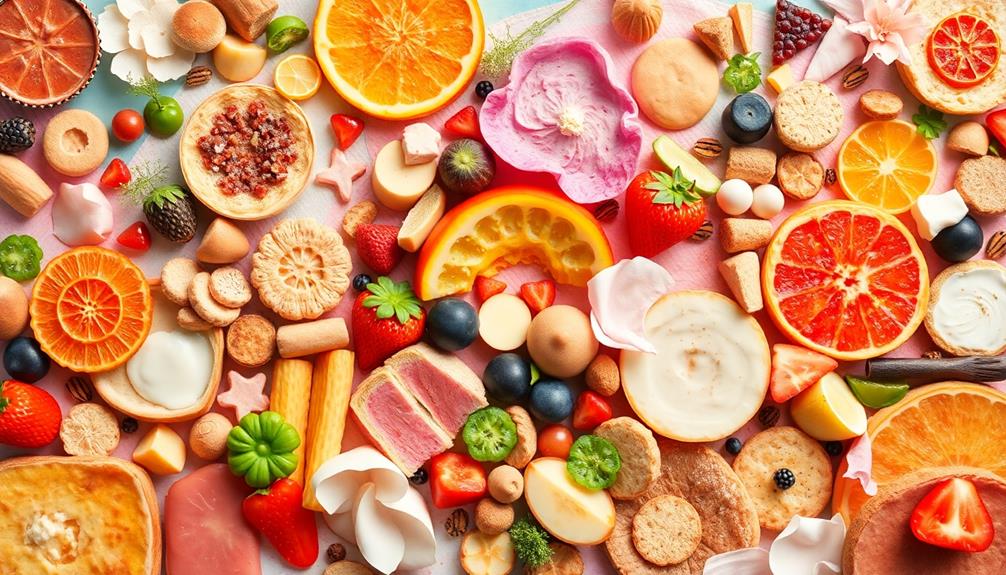
Your cravings during pregnancy aren't just about hunger; they're often shaped by your emotional state and the people around you.
For instance, certain seasonal events like Halloween can evoke nostalgic cravings for festive treats, such as Graveyard Taco Dip, which may remind you of cozy gatherings.
Stress or joy can trigger a desire for comfort foods, while the social context may lead you to indulge in specific treats.
Plus, environmental cues, like seeing a favorite dish, can quickly spark those cravings, making it essential to recognize these psychological influences.
Social Influence on Cravings
The interplay of social dynamics and emotional support can greatly influence food cravings during pregnancy. When you engage in conversations about food with friends or family, their cravings might trigger similar desires in you. This phenomenon often stems from cultural norms and societal expectations, which can either validate or guilt you regarding your cravings during pregnancy.
For instance, sharing experiences around classic American comfort foods, such as a Loaded Baked Potato, can evoke nostalgic feelings that intensify your cravings.
Consider these factors that can shape your experience:
- Social interactions: Sharing cravings or indulging together can amplify your desires.
- Cultural norms: Societal beliefs might make you feel justified or guilty about your cravings.
- Communal experiences: Celebrating pregnancy with food can intensify cravings.
- Social support: Partners and family often provide desired foods as gestures of care, fulfilling emotional needs.
- Events and indulgence: Pregnancy is often a time when indulgence is socially sanctioned, possibly leading to binge eating.
Emotional State Impact
Emotions play an essential role in shaping food cravings during pregnancy. You might notice that heightened emotional states, like stress or mood swings, often lead to a strong desire for comfort foods, such as creamy dishes like Nettle and Potato Soup that provide both warmth and nourishment.
These cravings serve as a coping mechanism, fulfilling emotional needs rather than nutritional gaps. When you share your cravings with friends or family, you could find that their responses trigger similar desires, a phenomenon known as psychological mirroring.
Cultural norms and societal expectations can also impact your cravings. You may feel guilty or justified in indulging based on what you perceive others expect from you during pregnancy. This interplay between emotional states and cravings can create a cycle that's hard to break.
To manage these cravings, consider incorporating mindfulness practices into your routine. By focusing on your feelings and recognizing underlying psychological triggers, you can address the root causes of your cravings.
This approach allows you to differentiate between emotional hunger and physical hunger, helping you make more conscious choices about what you eat. Remember, it's okay to indulge occasionally, but understanding your emotions can lead to a healthier relationship with food during this transformative time. Being mindful of how hunger impacts decisionmaking can empower you to pause and assess whether your cravings stem from a physical need or emotional response. This awareness helps create a balance between nourishing your body and addressing emotional triggers in healthier ways. By practicing this regularly, you can build lasting habits that support both your physical and emotional well-being.
Environmental Cues Effects
While maneuvering through the complexities of pregnancy, it's easy to notice how environmental cues can trigger intense food cravings. You might find yourself craving chocolate after catching a whiff of it at a bakery or seeing an advertisement for your favorite dessert. These sensory experiences can activate cravings that aren't always tied to nutritional needs but rather to emotional states and familiarity.
For instance, the festive atmosphere surrounding Halloween can evoke cravings for treats like Graveyard Taco Dip or spooky snacks, highlighting how seasonal events influence our desires.
Consider these factors that heighten your cravings:
- Food Advertisements: Visual and auditory stimuli can create strong desires for specific foods.
- Social Interactions: Talking about cravings with friends or family can lead to shared desires, emphasizing the psychological aspect.
- Smells: The scent of certain foods can trigger powerful memories and cravings.
- Cultural Norms: Societal views on indulgence during pregnancy can shape your cravings, making them seem more acceptable.
- Emotional States: Stress or happiness may drive you to seek comfort foods, reinforcing these cravings.
Understanding these environmental cues can help you navigate your cravings more effectively, allowing you to indulge mindfully without guilt.
Health Risks of Excessive Cravings

Excessive cravings during pregnancy can pose significant health risks that you need to be aware of. When you find yourself craving chocolate or other high-calorie, nutrient-poor foods, it's easy to overindulge. This can lead to excess weight gain during pregnancy, which in turn increases the risk of gestational diabetes and hypertension.
Studies show that between 1990 and 2003, around 20-25% of women gained more than 40 lbs during pregnancy, often due to such cravings. Additionally, cravings can influence dietary choices, potentially steering you away from healthier options, such as Turkey Soup, which is rich in nutrients and beneficial for both you and your baby.
Moreover, indulging in these cravings can cause digestive issues like indigestion and abdominal pain, complicating your pregnancy experience. The strong correlation between cravings for sweets and increased caloric intake can also trigger binge eating episodes, potentially leading to eating disorders.
This is especially concerning if you're already vulnerable to such issues.
Managing Cravings Effectively

Steering cravings during pregnancy can be challenging, especially after recognizing the health risks associated with overindulgence. However, you can effectively manage cravings by adopting a few practical strategies.
Start by planning smaller, balanced meals throughout the day to stabilize your blood sugar levels. This approach can reduce the intensity of your cravings, making them easier to handle.
Make sure you're staying hydrated, aiming for about 12 cups of water or caffeine-free beverages daily. Proper hydration can help curb those pesky cravings too.
When cravings do arise, consider healthier alternatives to satisfy them:
- Opt for small portions of dark chocolate instead of regular chocolate bars.
- Choose frozen yogurt over full-fat ice cream.
- Munch on fresh fruit when you're craving something sweet.
- Snack on nuts or seeds for a crunchy fix.
- Enjoy whole-grain crackers with a little cheese for a savory treat.
Incorporating mindfulness techniques can also help. Acknowledge your cravings without guilt and try distraction methods to shift your focus.
Regularly indulging in small amounts of your desired foods can prevent cravings from spiraling, leading to healthier eating patterns during pregnancy.
Seeking Medical Guidance

When it comes to managing cravings during pregnancy, seeking medical guidance can be invaluable. If you're a pregnant woman experiencing unusual cravings, especially for non-food items like dirt or chalk (a condition known as pica), it's essential to consult a healthcare professional. These cravings can signal potential nutritional deficiencies, such as iron-deficiency anemia, so regular hemoglobin checks are recommended.
You might also notice changes in your taste or smell during pregnancy. If these impairments lead to unusual cravings, discussing the possibility of zinc supplementation with your doctor could be beneficial.
Monitoring your nutrient intake and weight is vital, as excessive cravings can result in poor dietary choices and complications like gestational weight gain.
Healthcare providers can offer tailored advice on managing cravings and ensuring you maintain a balanced diet. This is important not only for your health but also for the well-being of your developing baby.
Frequently Asked Questions
What Happens if You Ignore Pregnancy Cravings?
If you ignore cravings, you might feel deprived, leading to unhealthy eating later. Unaddressed cravings can heighten stress and emotional discomfort, impacting both your physical health and mental well-being during this important time.
What Dictates Pregnancy Cravings?
Isn't it amusing how your cravings seem to dictate your life? Hormones, nutrient needs, and even social cues blend together, making you crave pickles at midnight or chocolate at breakfast. It's a deliciously chaotic blend!
What Hormone Causes Food Cravings During Pregnancy?
During pregnancy, increased levels of estrogen and progesterone can drive your food cravings. These hormonal changes heighten your sensitivity to taste, often making certain foods irresistible while creating aversions to others you once enjoyed.
Are Pregnancy Cravings What the Baby Needs?
Pregnancy cravings aren't always what your baby needs. While some cravings might signal nutrient deficiencies, many are influenced by hormones and cultural factors, leading you to desire comfort foods rather than essential nutrients for you both.
Conclusion
In summary, understanding pregnancy cravings is like steering through a winding road—you'll encounter twists and turns influenced by hormones, nutritional needs, and emotions. By being mindful of these cravings and managing them effectively, you can safeguard both your health and your baby's well-being. Don't hesitate to seek guidance from a healthcare professional if you're feeling overwhelmed. Embrace this unique journey, and remember, it's all part of the beautiful adventure of bringing new life into the world.


